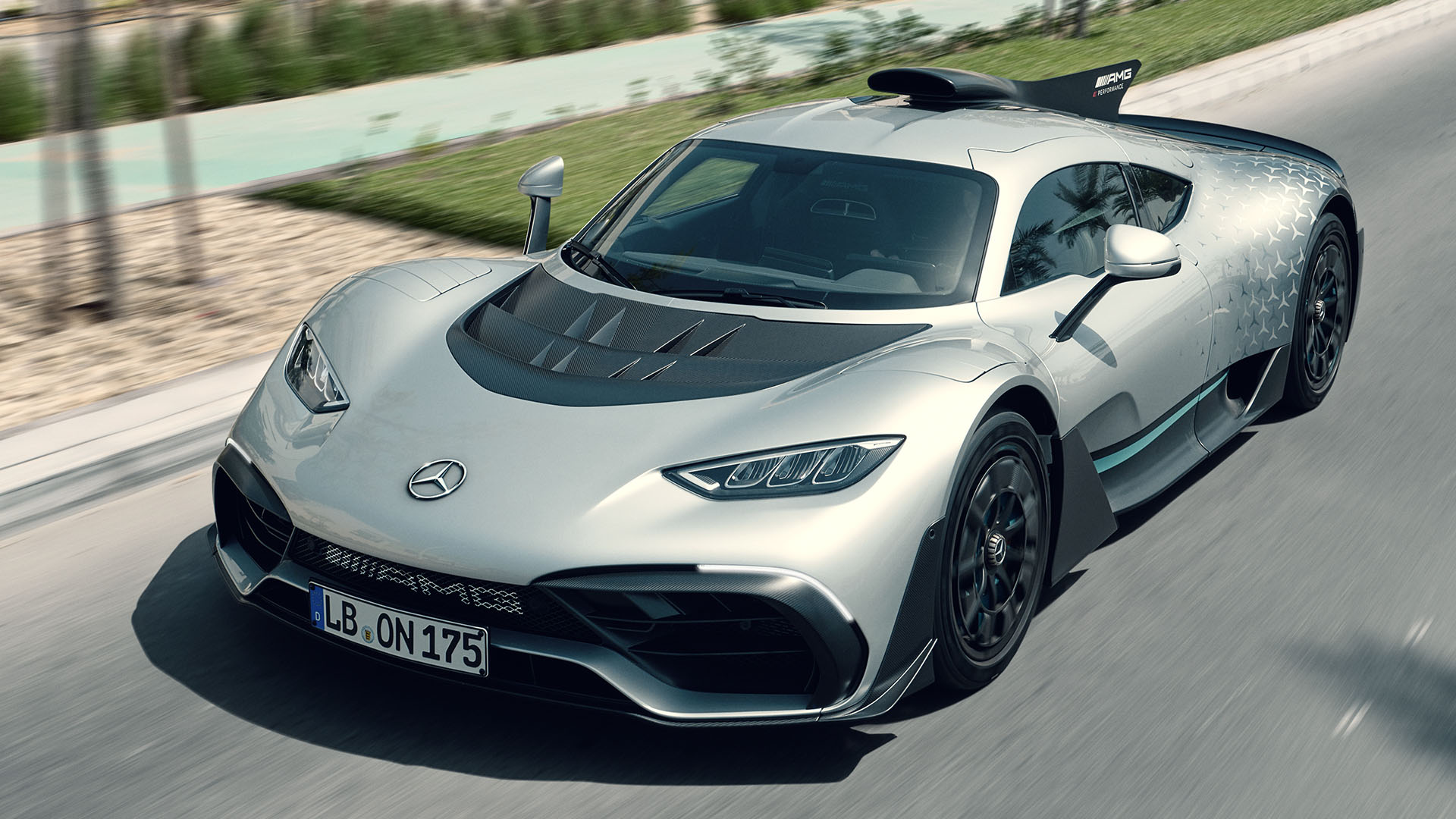

The Mercedes-AMG One is finally here after being in development hell for several years. Issues with emissions and pandemic-related delays meant a car that should’ve hit the streets a long time ago has just been formally launched on Wednesday. The specs of this hypercar are eye-popping, but one figure is a headscratcher: 3,737 pounds. That’s the weight for what should be a lightweight, F1-derived track monster, but by sifting through the car’s mechanical specs and examining its context, we can piece together why it’s such a big boy compared to its inspiration.
The first thing we need to do is lay out the basics of the vehicle’s drivetrain. It has not one, not two, but four electric motors. That’s five engines if you’re willing to call an electric motor an engine. Indeed, the drivetrain is probably a big part of the issue. In addition to having a 1.6-liter turbocharged V6 and a quartet of electric motors, the AMG One also carries around an 8.4 kWh liquid-cooled battery pack, a 3.7 kW onboard charger, and other power electronics.

That being said, it shouldn’t weigh this much if it takes so much of its design inspiration from an F1 car, right? The AMG One after all has a structural engine and transmission, just like an F1 car. The power output and therefore the weight of the various motors seems to be an issue, though. Yes, this car has a powerful internal combustion engine but once it has to be reliable on the street, get fed fuel from a gas station, and meet stringent emissions targets, it produces just 574 horsepower. That’s impressive from a 1.6-liter engine, but not so much when compared to other hybrid supercars—or even the One’s total output of 1,063 hp. Nearly half of the car’s power (489 hp) does not come courtesy of internal combustion.
The front axle has two motors and each of them produce 163 hp. Likewise, the engine itself also has a 163 hp electric motor mounted to its crankshaft. It’s all capped off by a motor-generator mounted between the compressor and exhaust sides of the turbo, which can deliver 122 hp. This output is likely necessary to generate the 51 PSI peak boost pressure needed to get nearly 600 horsepower from a 1.6-liter engine. All of these motors contribute significantly to the vehicle’s curb weight.
Below, you can see the weights of other hybrid supercars in the thousand horsepower range for comparison. I also included a Rimac Concept One for laughs. Just to show that there is still some weight to be saved by not totally ditching the combustion engine.

The real takeaway here seems to be that the more electronic gizmos and gadgets you put in a hybrid car—I do like gizmos and gadgets, don’t get me wrong—the heavier it gets. McLaren’s hybrids seem to strike a nice balance of electric power and engine performance. Other electrified machines from the likes of Ferrari, Porsche, and Mercedes, offer more motors, more batteries, more everything. As a contextual sidenote, I chose the Weissach version of the 918 Spyder because I’m really trying to judge the weight/complexity of these vehicles’ drivetrains, not necessarily how much everything else like the chassis and interior components weigh.
This context is important here. This thing is heavy for a supercar, but for a hybrid supercar? It’s just the heaviest of a bunch of reasonably heavy cars. A regular Porsche 918 Spyder is around the same weight as this thing, for instance. That’s still not really a complete explanation, though. Considering this car is absolutely willing to die on the hill of being F1-derived—and from an engine hardware perspective it absolutely is F1-derived—it doesn’t just get off for being a slightly portly hybrid.

The complete answer is likely a combination of factors beyond just a heavy hybrid system. Take, for instance, this vehicle’s emissions equipment. Reportedly, the AMG One had struggled to be clean enough for European roads in the past. Mercedes-AMG provided some details of the extensive steps taken to ensure the One emits a reasonable amount of carbon. “Four preheated metal catalytic converters, two ceramic catalytic converters, and two petrol particulate filters,” make up its emissions hardware. Yes, that’s six catalytic converters along with two particulate filters. Those four metal converters also have a heating system with a combined output of 16kW. All of these systems add weight, as well as sap power from the combustion engine.
Without understanding the issues the engineering team of this vehicle faced in order to get it on the road, it’s difficult to make a real evaluation though. The bottom line is that the devil is always in the details when it comes to creating something like this, and ultimately every car on the market is compromised in some way. This vehicle clearly had its fair share of struggles seeing as Mercedes’ board has joked they were drunk when they approved it.
In other words, yes it’s a bit chunky, but it’s still technically impressive and an engineering triumph either way. We should consider ourselves lucky that it’s finally on the road, even if it does weigh more than we might like.
Got a tip or question for the author? You can reach them here: peter@thedrive.com